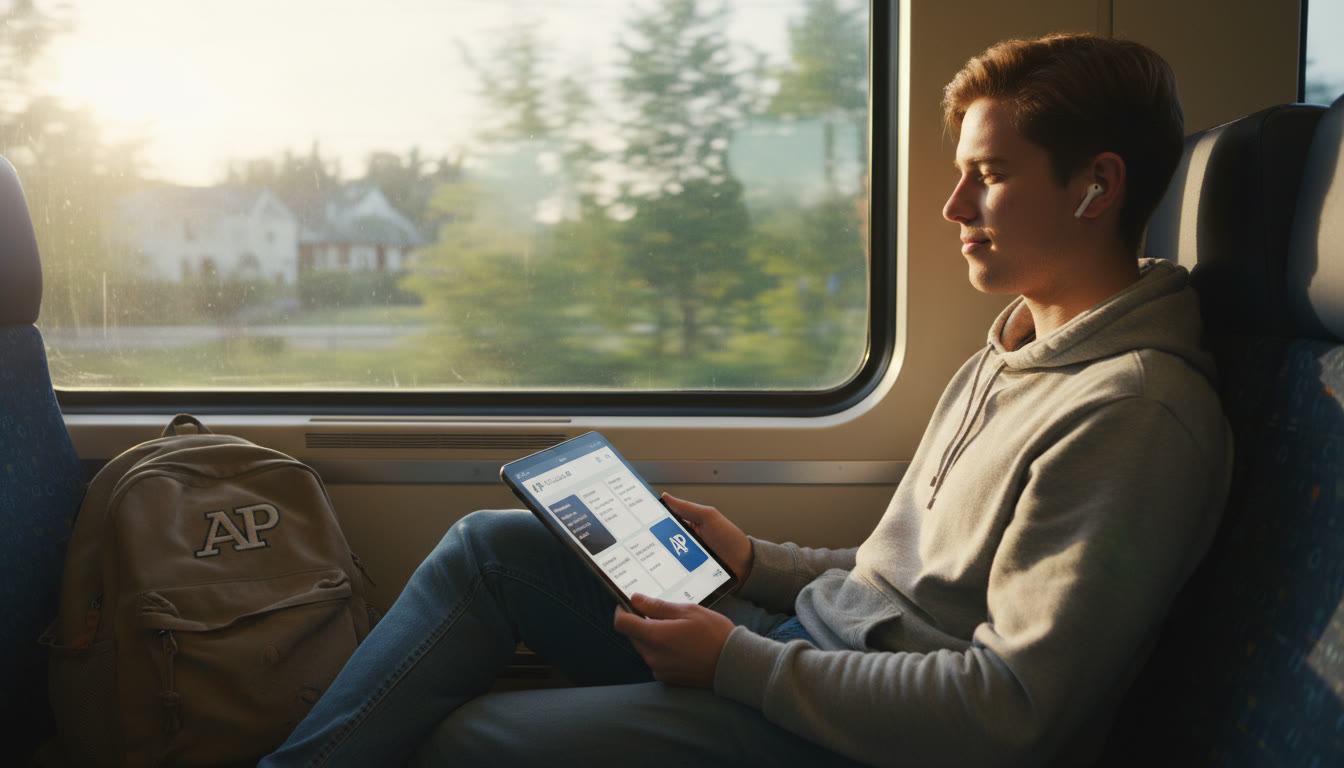Why Long Commutes Don’t Have to Stall Your AP Goals
For many students, day schools mean early alarms, backpacks full of textbooks and a one- to two-hour commute each way. At first glance, that time looks like lost time — sleep lost, chores postponed, social life squeezed. But what if those wheels-on-the-road hours could become your quietest, most focused study blocks? This blog is for students (and their parents) balancing long commutes with the pressure of AP courses and exams. You’ll learn how to craft micro-study systems that slot into travel, transform short bursts into durable learning, and keep motivation high without burning out the household.
Who this is for
- High school students enrolled in AP classes with daily long commutes.
- Parents who want supportive, realistic systems that respect family schedules.
- Caregivers and tutors searching for methods that preserve deep learning while coping with time constraints.

The Micro-Study Philosophy: Small, Consistent, and Strategic
Micro-study isn’t about cramming five pages in five minutes. It’s the deliberate design of small, repeatable learning activities that stack together into real mastery. Think of it like training a muscle: short, consistent workouts beat occasional marathons. For commuters, micro-study means turning transit minutes into targeted, low-friction learning sessions that preserve mental energy for the classroom and homework.
Core principles
- Precision — pick one clear goal per session (vocabulary, a practice problem, a concept summary).
- Variation — rotate activities to avoid boredom and reach different memory systems (recall, recognition, application).
- Spacing — revisit topics multiple times instead of one long review.
- Low friction — use tools and formats that require minimal setup and cleanup.
How to Split Your Commute Into High-Value Study Blocks
Not all commute time is created equal. Your attention in the first 10 minutes might differ from the last 10 before you step off the bus. Below is a practical way to divide a typical 60–90 minute round-trip commute into productive micro-sessions.
| Commute Segment | Average Time | Recommended Activity | Why It Works |
|---|---|---|---|
| Warm-up (first 5–10 mins) | 5–10 minutes | Light review: flashcards, vocabulary, concept summaries | Easy mental engagement; transitions from home to study mode |
| Deep Focus Block (15–25 mins) | 15–25 minutes | One focused problem or short passage practice (AP question) | Long enough for application; manageable in public transit |
| Reflection / Recall (5–10 mins) | 5–10 minutes | Summarize what you learned; speak aloud or write a sentence | Consolidates learning and strengthens retrieval |
| Wind-down (5–10 mins) | 5–10 minutes | Light planning: what to study tonight, list 1–2 goals | Transitions to school or home; reduces decision fatigue later |
These blocks can be rearranged to fit the realities of your transit — standing on a crowded bus calls for audio or flashcards; a quiet seat invites deeper problem work. The point is consistent, predictable rituals. After a week, your brain will expect learning in that slot and adapt to higher efficiency.
Micro-Study Tools That Fit in a Backpack (or a Pocket)
When commute time is limited, the last thing you want is fiddly technology or heavy books. Here’s a toolkit of low-friction resources that students report actually use.
- Digital flashcards (spaced-repetition enabled): short, discrete items that are quick to review and optimize retention.
- One-page concept sheets: single-sided summaries for each AP unit — could be printed or on a tablet.
- AP-style practice questions (one per session): short, focused, and immediately checked later for correction.
- Voice notes: record a 60-second verbal summary of a concept and replay for active recall.
- Annotatable PDFs: for reading passages or problem sets that you can mark up on a phone or tablet.
How parents can help
- Package short physical flashcard decks or a single sheet summary in the student’s daily bag.
- Create a calm transit kit: earbuds, a charged phone, and a slim notebook for reflections.
- Set up a weekly check-in: two minutes to ask what was learned on the commute and one small goal for the next week.
Sample Weekly Micro-Study Plan for an AP Student
Below is a compact week plan that balances class demands, commute sessions and at-home study. It assumes about 40–60 minutes round-trip transit daily and two hours total study each evening. The idea is to create reliable micro-habits that support weekly review and exam-style practice.
| Day | Commute Focus (each way) | Evening Focus |
|---|---|---|
| Monday | Vocabulary + 1 AP practice multiple choice | Review class notes, correct commute question, 20 mins targeted practice |
| Tuesday | One worked example (short problem) | Timed practice set (30 mins) + reflection |
| Wednesday | Audio summary replay (teacher voice note or student recording) | Deep practice on a weak subtopic + flashcard review |
| Thursday | Short reading passage or quick lab concept | Practice free-response outline + review |
| Friday | Weekly recap: list three things remembered | Light review or tutor session (if available) |
| Weekend | Reserve commute time for rest or review as needed | Full-length practice test segment or study block |
Turning Passive Time Into Active Learning
It’s tempting to scroll passively during a commute — that’s a reasonable choice sometimes — but a small shift in how you use your screen can yield big gains. Here are easy swaps.
- Instead of social feeds, open a 7-minute micro-quiz app or a set of 10 flashcards.
- Listen to a 10–15 minute concept explainer or lecture while watching the scenery go by.
- Use voice-to-text to summarize a chapter in 90 seconds — then save it to review later.
These micro-actions are low-stakes but high-value because they repeatedly retrieve and reinforce memory traces. Over a semester, retrieval practice beats rereading by a wide margin.
When You Need Deeper Support: Structured Tutoring That Fits the Commute Life
Micro-study is powerful, but sometimes students need targeted help: a tricky AP free-response strategy, pacing for exam day, or content gaps. That’s where personalized tutoring becomes a leverage point. A flexible tutor can convert commute time into focused coaching — for example, a short evening check-in, a weekly 1-on-1 deep dive, or an annotated audio feedback loop created from commute notes. Sparkl’s personalized tutoring model is designed around this reality: 1-on-1 guidance, tailored study plans, and expert tutors who adapt exercises so your commute minutes are used efficiently. When a tutor builds a curriculum that respects your transit, the gains compound: fewer hours, better results.
What to look for in tutoring
- Flexible scheduling that fits commute windows.
- Short focused touchpoints plus longer weekly sessions.
- Actionable homework that’s optimized for micro-sessions.
- Progress tracking with clear goals (not vague reassurance).
Real-World Strategies That Students Swear By
Below are practical techniques students have adapted to commute life. These are bite-sized and easy to try — pick two and use them for a week.
- One-Question Rule: solve exactly one AP-style question per commute. Correct it later at home if necessary.
- Two-Minute Recall: at the end of the ride, speak a two-minute verbal summary into your phone and save it.
- Priority Pairing: pair a high-value task (practice FRQ or passage) with a low-value reward (a favorite song or snack when you arrive).
- Pre-commit Packs: prepare a ‘commute pack’ each night with the exact materials for the next day to remove decision fatigue.
Avoiding Burnout: Balance, Sleep, and Family Support
Commuting increases time pressure. Micro-study systems help, but they can’t substitute for rest. Students who do the best over a year are those who protect their sleep, eat well, and create a predictable evening routine. Parents can support this by simplifying dinner on heavy commute days, helping with logistics and by encouraging realistic expectations — progress over perfection.
Household checklist
- Evening launch routine: pack commute kit, charge devices, set out clothes — cut morning chaos.
- Sleep-first mindset: treat sleep as non-negotiable study support, not a luxury.
- Weekly planning chat: ten minutes on Sunday to set goals for study blocks and tutoring sessions.
Tracking Progress: Simple Metrics That Actually Motivate
One reason micro-study works is clear feedback. Instead of vague ‘study more’, measure what matters. Use 3–4 simple metrics and track them weekly. Share progress with a tutor or parent for accountability.
| Metric | How to Measure | Target |
|---|---|---|
| Commute Sessions Completed | Count days you completed at least one micro-session | 80% of commute days |
| AP Practice Questions Correct | Record % correct on weekly set | Gradual increase week to week |
| Topics Reviewed Twice | Number of topics spaced across week | At least 3 topics weekly |
| Tutor Check-ins | Number of meaningful tutor actions (feedback, plan updates) | 1–2 per week as needed |
Sample Micro-Study Scripts — What To Say and Do
Scripts reduce hesitation. Use these short prompts for different commute activities.
- Flashcard Session (5–7 mins): “I’ll do 15 cards: 10 I should know, 5 to learn.”
- Problem Session (15 mins): “Read the question. Predict answer. Solve. Check. Note one mistake.”
- Reflection (5 mins): “What one idea stuck with me? How would I explain it in one sentence?”
When to Scale Up: From Micro to Macro Before the Exam
Micro-study carries you through daily learning. As exams approach, you’ll need to blend micro-sessions with longer practice blocks and full timed sections. That’s normal — keep the micro-habits, but reserve longer, uninterrupted blocks on weekends. Use commute micro-sessions for review and quick drills during this period.
Ramp-up plan (3–6 weeks before exam)
- Gradually replace lower-value commute activities with quick sections of timed practice.
- Use at least one weekend for a longer practice test + detailed review.
- Keep daily micro-sessions for retrieval and confidence maintenance.
Final Thoughts: Small Systems, Big Results
Long commutes to day school are a real challenge — but they’re also an opportunity. Micro-study systems turn fragmented minutes into a steady learning engine. When combined with intentional sleep, family support, and occasional targeted tutoring, you get a sustainable path toward AP success. If you’d like extra structure, tutoring options like Sparkl’s personalized approach can integrate micro-sessions into a tailored study plan so no commute minute is wasted. Start with one small change this week — a one-question commute or a two-minute recall — and let momentum build. In weeks, those minutes add up into real confidence on test day.

Quick Start Checklist
- Prepare a commute pack tonight: 1 concept sheet, 15 flashcards, earbuds.
- Pick your one-question rule for tomorrow’s rides.
- Schedule a 20-minute tutor check-in or review session this week if you need targeted help.
- Protect one night of full sleep — rest fuels learning more than extra late-night review.
Good luck — and remember: steady, smart habits beat last-minute heroics. With a little planning and the right micro-study habits, long commutes become part of your AP advantage, not an obstacle. You’ve got this.



















No Comments
Leave a comment Cancel